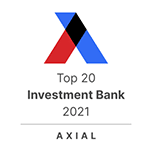
The Endless Summer of M&A?
Over fifty years ago in the late 1960’s filmmaker Bruce Brown gave us his cult classic surfer documentary The Endless Summer. The film chronicles the journey of two young professional surfers who circumnavigate the globe chasing summer through both the northern and southern hemispheres in search of the elusive “perfect wave.”
As we enter the summer of 2019, the comparison to the M&A market today seems appropriate. Are we in the “endless summer” of super charged M&A activity and valuations? We have been experiencing an almost unseen level of M&A activity over the past four years and one can’t help but ask….when (not if) will it end?
Mid-summer is not a time when folks typically think heavily about M&A, but rather a time to enjoy some sun, some time at the beach or at the lake with family, and time to reflect. During this time of relaxation and reflection, we decided to do some reflecting of our own and check in with our team to get some perspectives on where they believe the M&A market is today—and where it might be heading.
So, did the young surfers find the “perfect wave” they were seeking, or did they miss it? For those that haven’t seen The Endless Summer, I won’t spoil the show. However, I will share the problem with every perfect wave—albeit surfing or M&A. The “perfect wave” is long over before anyone realizes what they were riding.
Where’s Middle-Market M&A Headed?
“For now, the outlook is bullish, but most people we talk to (bankers, business owners, and CEOs) seem to agree a pullback is in the works, six to 12 months out. Confidence in global and local economies appears to be waning. This may be an opportunity for sellers, as the M&A market continues to be robust, and likely will continue at this pace while interest rates remain relatively low.”
“With the enormous amount of capital in private equity funds that needs to be invested, momentum should continue to be on the side of M&A market strength, but at some point, a monkey wrench in the gears will bring it to an end.”
“While financial investors were moving down market, now they are moving to higher quality and sustained long term growth. This may be good for the lower middle market—strategic investors will have less competition—and less price competition could keep sales moving in certain industries for at least another year.”
“The economy is strong, so companies are generally doing well. Combine that with the pending retirement of baby boomer business owners and an aggressive lending market and this creates a good backdrop for M&A activity.”
“Still looks very strong for rest of 2019, but most people I speak with are concerned about 2020. Many prospects and buyside targets are considering sale NOW in niches that are booming in value.”
Upside, Downside for Buyers?
“Lots of competition for the most attractive businesses. Long-term retention/development of people needed to operate and grow the businesses they acquire. Tough to identify attractive sectors given the level of competition in the marketplace.”
“M&A situations are very competitive. Buyers who go after strong companies need to be prepared to pay solid multiples, and also need to be very organized in terms of financing and the diligence process. Otherwise sellers will select other parties.”
“Deals are not just about valuation today—buyers must show they can add value to win deals.”
“Upside—strategic buyers flush with cash should be able to act quickly and decisively. Downside—plethora of financial buyers eager to employ funds boost prices and make middle market deals almost irrationally expensive. Feels like credit markets due for a correction.”
Upside and Downside for Sellers?
“Sellers have a good opportunity to exit in a hot market which may not last. They face increased scrutiny during diligence from prospects and banks expecting a downturn.”
“It’s a great time to sell a middle-market business. Despite the competition among buyers for attractive middle-market businesses, sellers should expect buyers to be rigorous in their due diligence. A typical due diligence process is more comprehensive than middle-market sellers anticipate.
“Now is still the near best time in a while to sell.”
“Work closely with your M&A advisor to be well-prepared. Sellers should resist inertia—don’t wait until you are ‘ready to retire’ to start the sale process; if you wait until you are ready, you have likely waited too long and may have limited your exit options.”
“The market is strong, and valuations are high, which obviously creates opportunities for sellers. Also, the amount of dry powder that PE firms have, and an aggressive debt market means the gap between what strategic and financial buyers will pay has basically disappeared.”
“Multiples have spiked for the very best companies, and I think this motivates investors to look at opportunities not as high quality but where they can get in at a lower multiple. This provides an opportunity for companies with issues like customer concentration, lack of management team depth, etc. to get a transaction done.”
“Difficult choices among good offers with strong buyers. More and more, final decisions are based on buyers’ plans for integration, post-sale treatment of management and employees, and buyers’ capabilities and plans to expand the business.”
“Seller’s market all the way. Get it done before election cycle. Where to put the money once they get liquid is biggest challenge.”
Parting Thoughts
- Picking the peak time to sell is an incredibly risky business, but it really does feel like the market is extraordinarily strong today and perhaps at the crest of the “wave.”
- Financial buyers are making a huge impact on this market and appear to be just as competitive as strategic buyers in terms of valuation.
- Winning bids are increasingly not just about price at closing today but plans and ability for a successful future of the company are far more relevant.
- A market correction may not be inevitable, but it sure feels like the endless summer of M&A may be starting to burn out as well.













